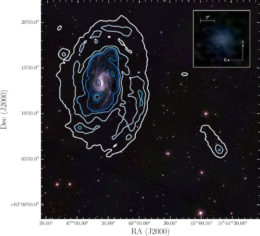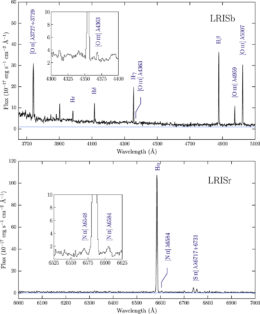The discovery of an extremely metal-poor star-forming galaxy in our local universe, dubbed Little Cub, is providing astronomers with front-row seats to the quenching of a near-pristine galaxy.

SDSS image of NGC 3359 (left) and Little Cub (right), with overlying contours displaying the location of hydrogen gas. Little Cub’s (also shown in the inset) stellar mass lies in the blue contour of the right-hand side. The outer white contours show the extended gas of the galaxy, likely dragged out as a tidal tail by Little Cub’s interaction with NGC 3359. [Hsyu et al. 2017]
The Hunt for Metal-Poor Galaxies
Low-metallicity, star-forming galaxies can show us the conditions under which the first stars formed. The galaxies with the lowest metallicities, however, also tend to be those with the lowest luminosities — making them difficult to detect. Though we know that there should be many low-mass, low-luminosity, low-metallicity galaxies in the universe, we’ve detected very few of them nearby.
In an effort to track down more of these metal-poor galaxies, a team of scientists led by Tiffany Hsyu (University of California Santa Cruz) searched through Sloan Digital Sky Survey data, looking for small galaxies with the correct photometric color to qualify a candidate blue compact dwarfs, a type of small, low-luminosity, star-forming galaxy that is often low-metallicity.
Hsyu and collaborators identified more than 2,500 candidate blue compact dwarfs, and next set about obtaining follow-up spectroscopy for many of the candidates from the Keck and Lick Observatories. Though this project is still underway, around 100 new blue compact dwarfs have already been identified via the spectroscopy, including one of particular interest: the Little Cub.
Little Cub
This tiny star-forming galaxy gained its nickname from its location in the constellation Ursa Major. Little Cub is perhaps 50 or 60 million light-years away, and Hsyu and collaborators find it to be one of the lowest-metallicity star-forming galaxies in our local universe. The galaxy contains ~100,000 solar masses of stars and it is notably gas-rich — with nearly 100 times the stellar mass in neutral gas.
The environment of Little Cub is also interesting: it appears to be just a couple hundred thousand light-years away from the grand design spiral galaxy NGC 3359. The galaxies’ proximity and kinematics suggest that Little Cub may be a companion of NGC 3359, and Little Cub’s morphology indicates that the larger galaxy may be tidally stripping gas from it.
A First Passage?
If Little Cub is indeed being tidally stripped by NGC 3359, then it’s surprising that the small galaxy still contains so much hot, star-forming gas; timescales for tidal stripping of this sort are thought to be very short. Hsyu and collaborators therefore speculate that we may have caught Little Cub in the early stages of its first passage around NGC 3359, allowing us to witness the quenching of a near-pristine satellite by a Milky-Way-like galaxy.
This quenching process is thought to commonly happen around other massive host galaxies in the universe — including around our own Milky Way, where nearly all satellite galaxies within roughly a million light-years are already quiescent and contain little neutral gas. Little Cub provides us with a rare opportunity to watch this process in action in our nearby universe, and it will be an intriguing laboratory for testing our understanding of dwarf satellite galaxy evolution.
Citation
Tiffany Hsyu et al 2017 ApJL 845 L22. doi:10.3847/2041-8213/aa821f



1 Comment
Pingback: metal poor dwarf being stripped